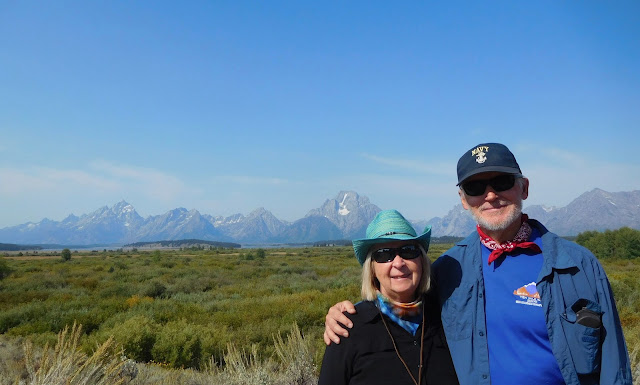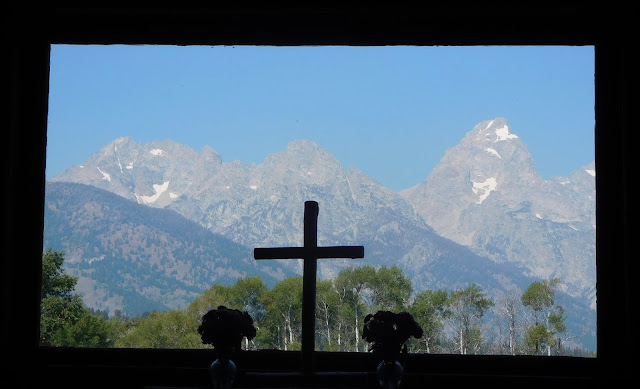Carol writes: Yellowstone National Park was established in 1872 as our first national park. Situated in a dramatic volcanic backdrop like something from another world, the park is located primarily in Wyoming but also extends into parts of Montana and Idaho. There is nothing commonplace in Yellowstone’s untamed landscape where there are over 300 active geysers that are still heated by a giant magma chamber that last erupted 640,000 years ago and covered approximately half of the continental United States with ash fall.
In addition to geothermal features, Yellowstone is the habitat for an increasingly scarce population of large predator and prey mammals, such as
grizzly bear,
elk,
and our country’s largest free-roaming bison herd.
Our gourmet campground in West Yellowstone was conveniently located just outside the entry to the park. We were happy to be joined for the first 4 days of our 2-week stay by Mississippi pals Mike and Mary, friends of ours from back in the days of our early married life when we lived in Slidell, Louisiana. I must give a huge round of thanks to Mike, who shot several of the photos in this blog due to a fatal malfunction by Al's camera.
Blessed with sunny skies on the first day, we were all quite enthused as we headed out to the magical land of Norris Geyser Basin for a hike around Yellowstone’s hottest and most dynamic geyser basin.
Ribbons of color formed by microorganisms growing in waters of varying temperatures and pH streamed throughout a primordial landscape.
Fondly, we remembered that Yellowstone was one of the stops we made in 1989 while our family of four was on a year of travel after Al retired from the Navy. For some reason, tiny little Vixen Geyser in Norris Geyser Basin was a family favorite back then, as related in Al’s blog from exactly 28 years ago today…
Family Journal Entry from September 19, 1989:
“We were all treated to a special performance from the Vixen Geyser. It is a small geyser about 10 feet from the trail and as soon as we walked up to it, the little girl showed us her stuff. Vixen gave us a 4-5 minute show with spouts of water about 25 feet high and then sucked all the water back down her vent.”
It was with a touch of sentimentality that we observed that Little Vixen was still firing away!
The next day it was on to the Old Faithful geyser basin
for one of the Yellowstone “big shows.” I guess you could say we were a bit excited about our first bison sighting along the road,
and what else the day would bring,
as we spotted a Yellowstone shout-out to Mary beside the road.
After Mike and Al did a little strategizing and coordinating known geyser eruption times,
Old Faithful went off precisely as predicted.
We were fortunate to witness an even grander eruption than Old Faithful at Grand Geyser.

Grand’s eruption was a big hit with the crowd, as it seemed higher and more dramatic than Old Faithful’s and certainly lasted much longer.
Despite not being in the business of dramatic eruptions, Solitary Geyser gifted the four of us with our own private moment of reflection on the fortunate opportunity of being together amidst the marvels of Yellowstone.
A hike in the Old Faithful geyser basin displayed an array of colorful thermal features…

and another bison sighting.
On the ride back to camp, we delighted in our first Yellowstone elk sighting along the Madison River. Strange we haven’t heard any bugling from the bull elks yet, for it is the mating season…
The next day we traveled further into the park to see the most popularly photographed Grand Canyon of the Yellowstone.
For the hardy, there were excellent short hikes along boardwalks with lots of steps and several hundred feet of elevation change to viewpoints of the Lower Falls

and the Upper Falls, where each couple took turns getting their vanity shot.
Mike's photo of an extraordinary rainbow effect looking down the Grand Canyon of the Yellowstone with its honey-colored walls left little doubt why this area was named Yellowstone.
For our last day with Mike and Mary in Yellowstone, Mike proposed a couple of hikes for an off-the-road experience that a majority of park visitors are unable to undertake due to time constraints. We were very thankful for the opportunity to see the “back side” of Yellowstone, for that is where the quiet spirit of the land revealed itself in all its splendor.
The ride to our trailhead went through spectacular Hayden Valley, the best area of the park for viewing large-animal wildlife. Sure enough, in the grand vista of Hayden Valley in what was once an ancient lakebed, we spotted a sizable bison herd grazing on the yellow grasses of late summer.
all the while thankful for cameras with great zoom features…
For the first hike of the day, Mary headed out at a brisk pace to Storm Point along Yellowstone Lake to a place where there were few other hikers, leaving us all alone to soak up the beauty and serenity of the shoreline of this amazing lake.
The second hike to Riddle Lake was likewise quite deserted, thus providing us a golden opportunity to enjoy the silence of a mostly lodgepole pine forest interspersed with wet grassy meadows.
As we were resting lakeside preparing for the hike back, a brief fly-by and a honk from a resident trumpeter swan struck each of us as positively spiritual.
Having had a glimpse into the soul of Yellowstone at its geysers and thermal pools, we were thankful for the camaraderie of exploring along with friends. So far, we had been blessed with fair skies and warm breezes, but we still had another week and a half in Yellowstone by ourselves—with a weather forecast that was turning positively wintery. However, having last visited a frozen Yellowstone
 |
| Upper Falls of the Yellowstone, January 2010 |
for a snowmobile adventure during the heart of winter in January 2010,
 |
| Snowmobile Trip to Yellowstone, January 2010 |
we knew we were about to have another memorable experience viewing Yellowstone’s untamed landscape through the winter lens of our camera. How would that work out this time in a home on wheels?


























































